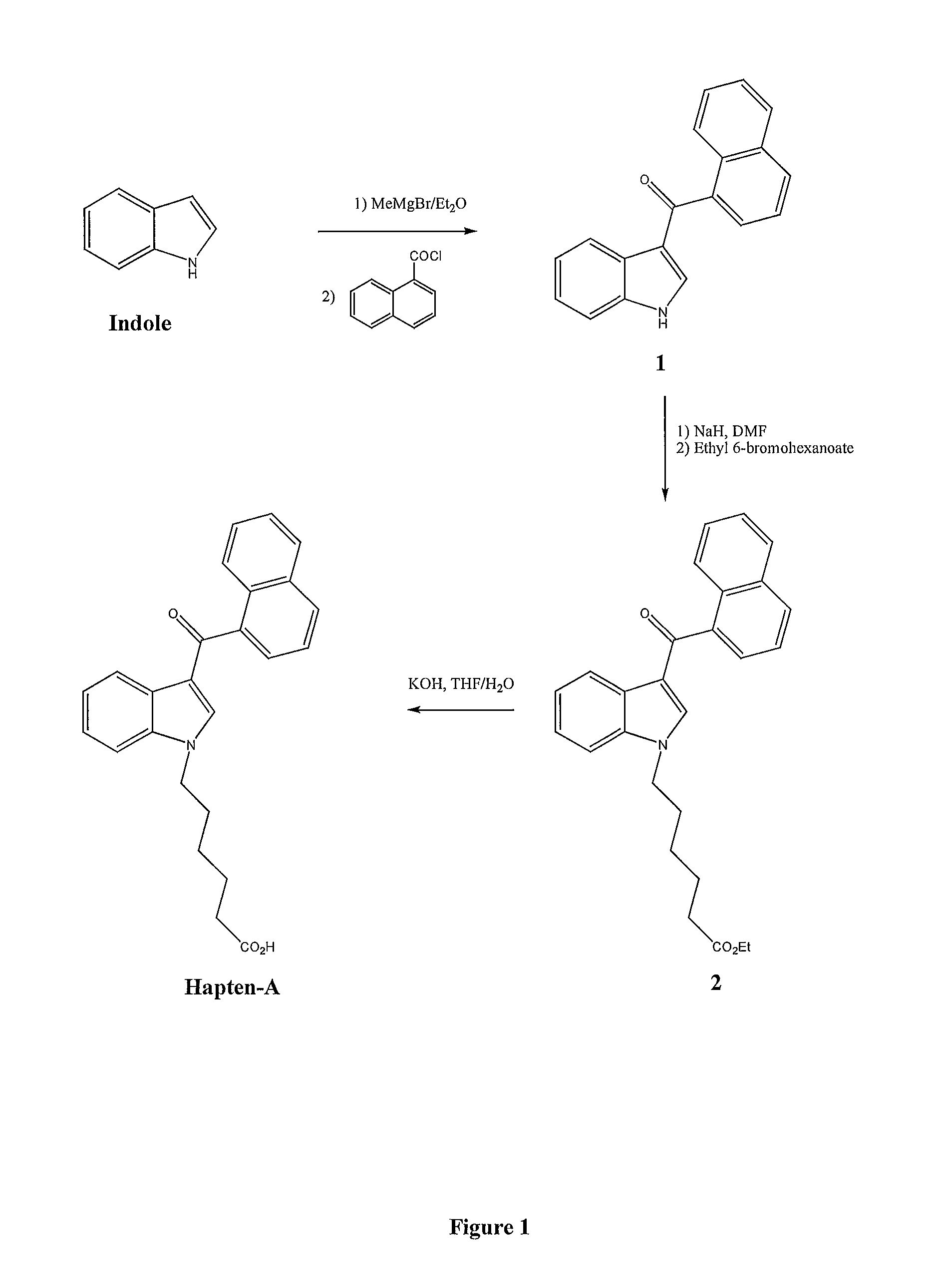Detection of synthetic cannabinoids
a synthetic cannabinoid and detection technology, applied in the field of detection of synthetic cannabinoid, can solve the problems of insufficient detection method, insufficient characterisation, and further resource intensive and costly chemical analytical study
- Summary
- Abstract
- Description
- Claims
- Application Information
AI Technical Summary
Benefits of technology
Problems solved by technology
Method used
Image
Examples
example — 1
Example—1
Preparation of 3-(1-naphthoyl)-1H-indole 1
[0036]To a cooled solution of indole (5.85 g, 50 mmol) in ether (50 ml) under nitrogen was added slowly a solution of methylmagnesium bromide (3M) in ether (17.5 ml). After addition, the reaction mixture was warmed up to room temperature and stirred for 2 h at room temperature. Then the mixture was cooled down again to 0° C., and to it was added slowly with stirring a solution of 1-naphthoylchloride (9.5 g, 50 mmol) in ether (50 ml). The resulting mixture was warmed up to room temperature and stirred for 2 h at room temperature followed by slow addition of saturated ammonium chloride solution (375 ml). The mixture was then stirred overnight at room temperature. A white solid was formed, filtered, washed by ether and dried under high vacuum to give 3-(1-naphthoyl)-1H-Indole 1 (12.3 g, 91%).
example — 2
Example—2
Preparation of N-(5-Ethoxycarbonylpentyl)-3-(1-naphthoyl)-1H-indole 2
[0037]To a suspension of sodium hydride (1.1 g, 30 mmol, 60% in mineral oil) in DMF (100 ml) under nitrogen was added solid 3-(1-naphthoyl)-1H-indole 1 (5.43 g, 20 mmol). After stirring at room temperature for 1 h, a solution of ethyl 6-bromohexanoate (6.6 g, 30 mmol) in DMF (10 ml) was added slowly with stirring over a period of 15 min and the mixture was then heated at 60° C. for 3 h. The solvent was removed under high vacuum and the crude product was suspended in water (150 ml) and extracted by ethyl acetate (2×150 ml). The combined ethyl acetate phases were washed by water (1×100 ml), brine (1×100 ml), dried over sodium sulphate filtered and concentrated to dryness. The crude product obtained was purified by chromatography on silica gel using hexane / ethyl acetate (8 / 2) to give the title compound 2 as an oil which became solid in the cold (7.1 g, 86%).
example — 3
Example—3
Preparation of N-(5-carboxypentyl)-3-(1-naphthoyl)-1H-indole (Hapten-A)
[0038]To a solution of 2 (5.0 g, 12 mmol) in a mixture of THF / H2O (1:1) was added potassium hydroxide (1.7 g) and the mixture was stirred at 60° C. for 1 h. The THF was removed under vacuum, the aqueous solution acidified to pH 1 by the addition of hydrochloric acid solution (1N) and extracted by ethyl acetate (3×100 ml). The combined organic phases were washed by water (100 ml), brine solution (100 ml), dried over sodium sulphate, filtered and concentrated to dryness. The crude product obtained was dissolved in ethyl acetate (10 ml) and the Hapten-A precipitated by the addition of a mixture of ether / hexane as a white solid, filtered and dried under high vacuum to give Hapten-A (3.6 g, 78%).
PUM
| Property | Measurement | Unit |
|---|---|---|
| temperature | aaaaa | aaaaa |
| pH | aaaaa | aaaaa |
| pH | aaaaa | aaaaa |
Abstract
Description
Claims
Application Information
 Login to View More
Login to View More - R&D
- Intellectual Property
- Life Sciences
- Materials
- Tech Scout
- Unparalleled Data Quality
- Higher Quality Content
- 60% Fewer Hallucinations
Browse by: Latest US Patents, China's latest patents, Technical Efficacy Thesaurus, Application Domain, Technology Topic, Popular Technical Reports.
© 2025 PatSnap. All rights reserved.Legal|Privacy policy|Modern Slavery Act Transparency Statement|Sitemap|About US| Contact US: help@patsnap.com



